Sprouts Farmers Market Bundle
How Did Sprouts Farmers Market Blossom from a Single Store?
Discover the fascinating Sprouts Farmers Market SWOT Analysis and the story of a grocery store chain that revolutionized the way we think about healthy eating. From its humble beginnings in Arizona in 2002, Sprouts has grown into a significant player in the organic produce market. Learn about the vision that fueled its expansion and the key milestones that shaped its journey.
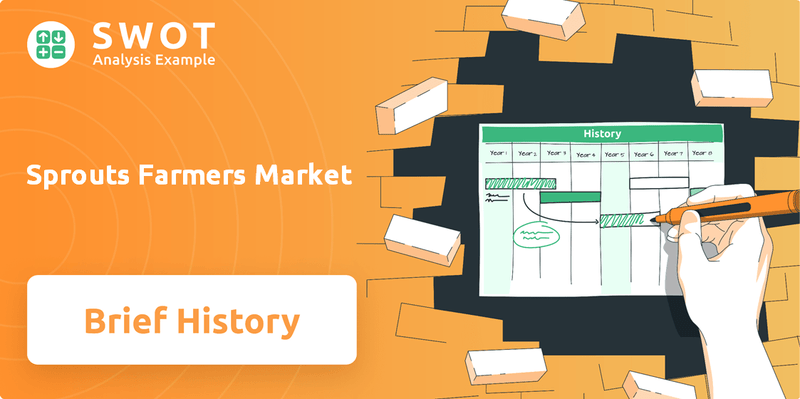
This exploration into the Sprouts company will uncover its origin story, tracing its roots from a single store to a national footprint. We'll examine the strategic decisions that propelled its growth, including its commitment to providing accessible and affordable healthy food options. Understanding the brief history of Sprouts Farmers Market is key to appreciating its impact on the grocery industry and its future potential.
What is the Sprouts Farmers Market Founding Story?
The Sprouts Farmers Market story began on July 17, 2002. The company was founded by the Boney family, including Stan Boney, Shon Boney, and Todd Boney, along with Scott Jones. Their vision was to create a grocery store chain that offered fresh, natural, and organic foods at competitive prices.
The Boney family's experience in the grocery business, particularly with Henry's Farmers Market, gave them a strong foundation. They recognized a market need for accessible and affordable healthy food options. The founders aimed to provide a farmers market-style experience inside a traditional grocery store format.
The initial business model focused on fresh produce, natural meats, bulk items, and vitamins and supplements. The first store opened in Chandler, Arizona. The name 'Sprouts Farmers Market' reflected the company's commitment to fresh, healthy products and its farmers market-style approach. Funding came from the Boney family and private investors, allowing them to control their vision.
The early days of Sprouts Farmers Market were marked by a clear vision and a focus on a specific market need.
- Founding Date: July 17, 2002.
- Founders: Boney family (Stan, Shon, Todd) and Scott Jones.
- Business Model: Farmers market-style grocery store.
- Initial Focus: Fresh produce, natural meats, bulk items, vitamins, and supplements.
- First Location: Chandler, Arizona.
Sprouts Farmers Market SWOT Analysis
- Complete SWOT Breakdown
- Fully Customizable
- Editable in Excel & Word
- Professional Formatting
- Investor-Ready Format
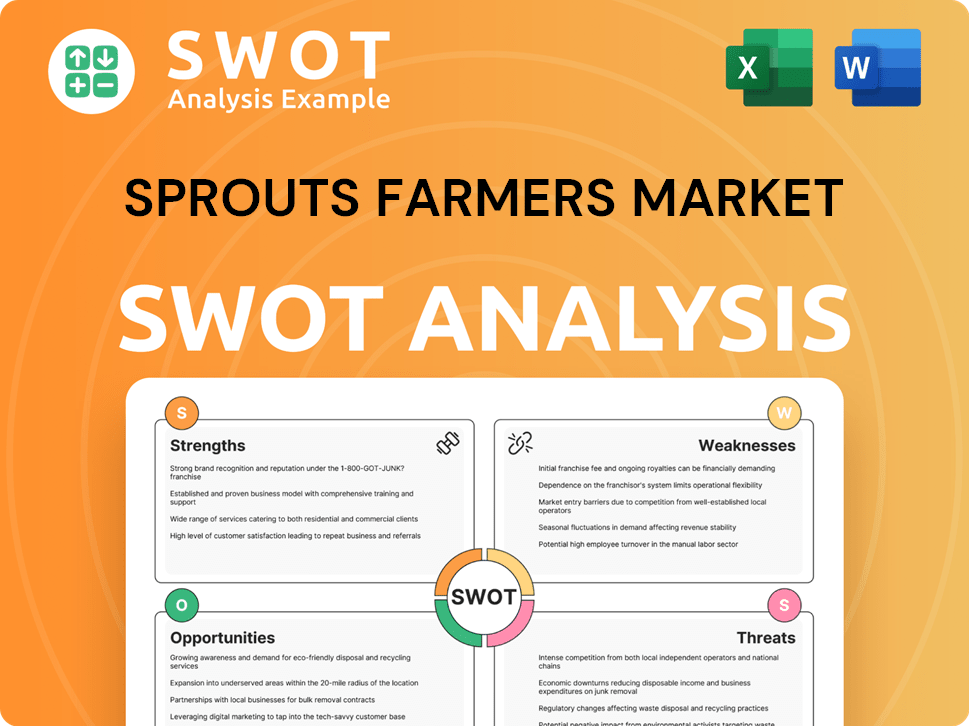
What Drove the Early Growth of Sprouts Farmers Market?
The early years of Sprouts Farmers Market were marked by rapid expansion, quickly moving beyond its initial base. This grocery store chain distinguished itself by offering natural and organic foods at competitive prices, focusing on fresh produce. This strategy resonated with consumers seeking healthier options without the premium price tags, driving early growth and market penetration.
A pivotal moment in the Sprouts history was the 2011 merger with Henry's Farmers Market and Sun Harvest Farms, then under Apollo Management. This significantly increased the store count and market presence, particularly in California and Texas. This strategic move solidified its position as a major player in the natural and organic grocery sector.
Following the merger, Sprouts Farmers Market continued its aggressive store expansion. By the end of 2012, the company operated over 150 stores, showcasing a strong growth trajectory. The company's focus remained on a decentralized store format, emphasizing fresh perimeter categories.
The company's initial public offering (IPO) in August 2013, trading on NASDAQ under the ticker SFM, provided capital for further expansion. This IPO demonstrated the company's strong performance and investor confidence. The Sprouts company's expansion strategy was fueled by the growing demand for natural foods.
The Sprouts Farmers Market business model emphasized a decentralized store format, focusing on fresh perimeter categories, including produce, meat, seafood, and deli. This strategy aimed to maintain the freshness and quality of perishable offerings. This approach was key to its success as a healthy food retailer.
Sprouts Farmers Market PESTLE Analysis
- Covers All 6 PESTLE Categories
- No Research Needed – Save Hours of Work
- Built by Experts, Trusted by Consultants
- Instant Download, Ready to Use
- 100% Editable, Fully Customizable
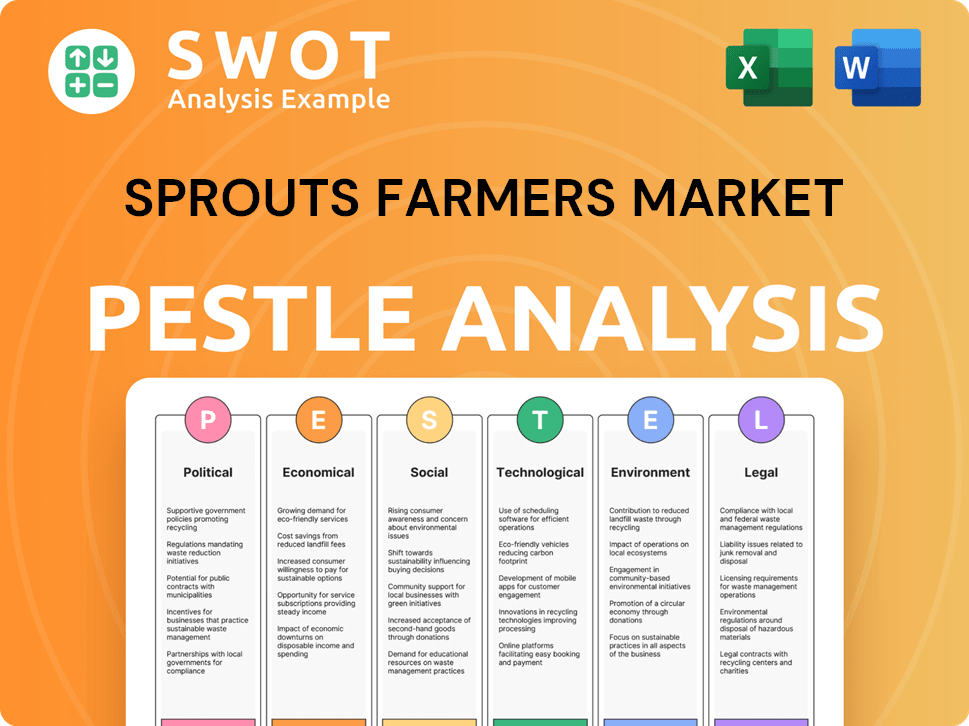
What are the key Milestones in Sprouts Farmers Market history?
The Sprouts Farmers Market has achieved several significant milestones throughout its history, marking its growth and impact in the grocery store chain market. These achievements reflect its evolution as a healthy food retailer.
| Year | Milestone |
|---|---|
| 2002 | The first store opened in Chandler, Arizona, establishing the foundation for the Sprouts Farmers Market. |
| 2011 | The company reached 50 stores, demonstrating significant early growth and market acceptance. |
| 2013 | Sprouts Farmers Market completed its Initial Public Offering (IPO), raising significant capital for expansion. |
| 2020 | Sprouts Farmers Market had over 350 stores across the United States, showcasing its rapid expansion. |
| Early 2024 | The company operated over 400 stores across more than 20 states, continuing its growth trajectory. |
Sprouts Farmers Market has consistently innovated to maintain its competitive edge. A key focus has been on offering a differentiated store format, emphasizing fresh, healthy, and organic products at competitive prices.
Sprouts Farmers Market has distinguished itself through its focus on fresh, healthy, and organic products, setting it apart from conventional grocery stores. This unique format attracts a loyal customer base.
The company enhanced its e-commerce capabilities, including the introduction of Sprouts.com for online ordering and delivery. This expansion caters to evolving consumer shopping habits.
Sprouts Farmers Market has expanded its private label offerings to improve margins and customer loyalty. This strategy provides customers with value and strengthens brand recognition.
Sprouts Farmers Market has faced several challenges as it has grown and evolved. The competitive grocery landscape, including increased natural and organic offerings from mainstream supermarkets, has put pressure on Sprouts Farmers Market to maintain its market share.
The grocery industry is highly competitive, with increased offerings from mainstream supermarkets and the rise of online grocery services. This intensifies the need for Sprouts Farmers Market to maintain its unique value proposition.
Supply chain disruptions, especially during periods of economic volatility, have posed operational hurdles, impacting product availability and pricing. Agile supply chain management is crucial for mitigating these impacts.
Maintaining consistent quality and freshness across a rapidly expanding store footprint has been an ongoing challenge. The ability to deliver high-quality products is essential for customer satisfaction.
Adapting to technological advancements in retail, such as online ordering and delivery services, is crucial for staying competitive. Continuous innovation in product assortment is also vital.
Periods of economic volatility can impact consumer spending and supply chain stability. Sprouts Farmers Market must navigate these challenges through strategic pivots and agile management.
Optimizing the store footprint by focusing on smaller, more efficient stores is a strategic response to market challenges. This approach can improve operational efficiency and profitability.
For more insights into Sprouts Farmers Market's strategic moves, consider reading about the Growth Strategy of Sprouts Farmers Market.
Sprouts Farmers Market Business Model Canvas
- Complete 9-Block Business Model Canvas
- Effortlessly Communicate Your Business Strategy
- Investor-Ready BMC Format
- 100% Editable and Customizable
- Clear and Structured Layout
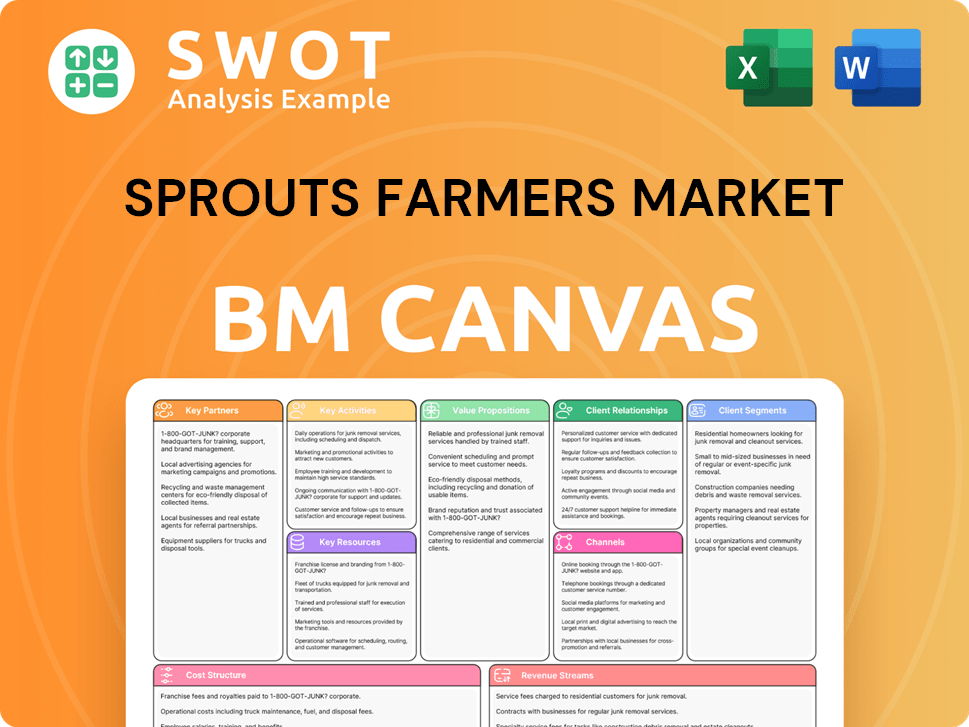
What is the Timeline of Key Events for Sprouts Farmers Market?
The Sprouts Farmers Market journey reflects strategic growth, adapting to market demands. From its founding in Chandler, Arizona, the Sprouts history is marked by mergers, public offerings, and expansions. The grocery store chain has consistently increased its store count, embraced digital platforms, and adapted to changing consumer behaviors, celebrating two decades in 2022 and currently operating over 400 stores across more than 20 states. This healthy food retailer has demonstrated resilience and a commitment to its core values.
| Year | Key Event |
|---|---|
| 2002 | Sprouts Farmers Market was founded in Chandler, Arizona. |
| 2011 | Merged with Henry's Farmers Market and Sun Harvest Farms, significantly expanding its store count. |
| 2013 | Successfully completed its Initial Public Offering (IPO) on NASDAQ (SFM). |
| 2015 | Reached 200 stores, demonstrating consistent expansion. |
| 2018 | Launched Sprouts.com for online ordering and expanded delivery services. |
| 2020 | Navigated operational challenges and increased demand during the COVID-19 pandemic, adapting its services. |
| 2022 | Celebrated 20 years of operations, continuing its focus on fresh, natural, and organic foods. |
| 2024 | Operates over 400 stores across more than 20 states, continuing its expansion trajectory. |
| 2025 | Continues to focus on strategic growth in new and existing markets, emphasizing smaller format stores and enhanced digital offerings. |
Sprouts Farmers Market plans to open 30 new stores in 2024, showcasing its commitment to growth. The company aims for a 10% annual increase in store count, focusing on efficiency through smaller-format stores. This expansion strategy is designed to reach diverse market demographics and enhance accessibility.
Enhancing the customer experience is a key focus, with improvements planned for its e-commerce platform and personalized marketing. These digital initiatives aim to boost customer engagement and streamline the shopping process. The strategy includes leveraging data to better understand and meet customer needs.
Expanding its private label offerings is part of Sprouts Farmers Market's strategy to increase margins and build customer loyalty. Private label products often provide higher profitability and allow for greater control over product quality and branding. This approach strengthens the company's market position.
Consumer demand for healthy, sustainable, and convenient food options is expected to benefit Sprouts Farmers Market. However, competition from conventional grocers and online grocery services remains a key factor. Analyst predictions generally show a positive outlook, given its market position and strategic initiatives. You can learn more about Sprouts Farmers Market in this article about its history and business model: Sprouts Farmers Market.
Sprouts Farmers Market Porter's Five Forces Analysis
- Covers All 5 Competitive Forces in Detail
- Structured for Consultants, Students, and Founders
- 100% Editable in Microsoft Word & Excel
- Instant Digital Download – Use Immediately
- Compatible with Mac & PC – Fully Unlocked
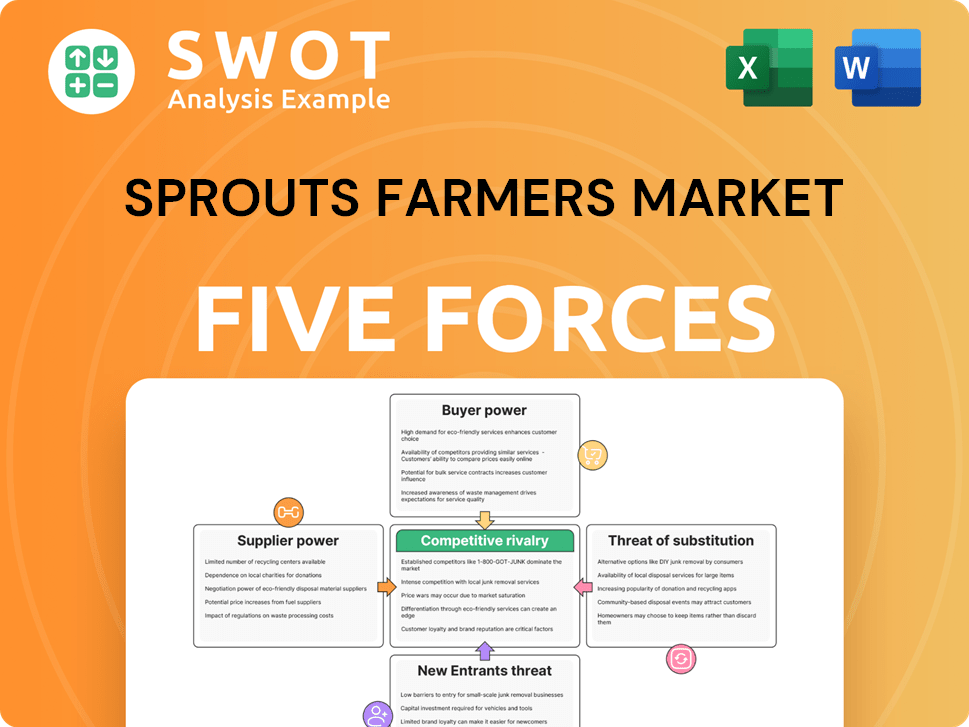
Related Blogs
- What is Competitive Landscape of Sprouts Farmers Market Company?
- What is Growth Strategy and Future Prospects of Sprouts Farmers Market Company?
- How Does Sprouts Farmers Market Company Work?
- What is Sales and Marketing Strategy of Sprouts Farmers Market Company?
- What is Brief History of Sprouts Farmers Market Company?
- Who Owns Sprouts Farmers Market Company?
- What is Customer Demographics and Target Market of Sprouts Farmers Market Company?
Disclaimer
All information, articles, and product details provided on this website are for general informational and educational purposes only. We do not claim any ownership over, nor do we intend to infringe upon, any trademarks, copyrights, logos, brand names, or other intellectual property mentioned or depicted on this site. Such intellectual property remains the property of its respective owners, and any references here are made solely for identification or informational purposes, without implying any affiliation, endorsement, or partnership.
We make no representations or warranties, express or implied, regarding the accuracy, completeness, or suitability of any content or products presented. Nothing on this website should be construed as legal, tax, investment, financial, medical, or other professional advice. In addition, no part of this site—including articles or product references—constitutes a solicitation, recommendation, endorsement, advertisement, or offer to buy or sell any securities, franchises, or other financial instruments, particularly in jurisdictions where such activity would be unlawful.
All content is of a general nature and may not address the specific circumstances of any individual or entity. It is not a substitute for professional advice or services. Any actions you take based on the information provided here are strictly at your own risk. You accept full responsibility for any decisions or outcomes arising from your use of this website and agree to release us from any liability in connection with your use of, or reliance upon, the content or products found herein.